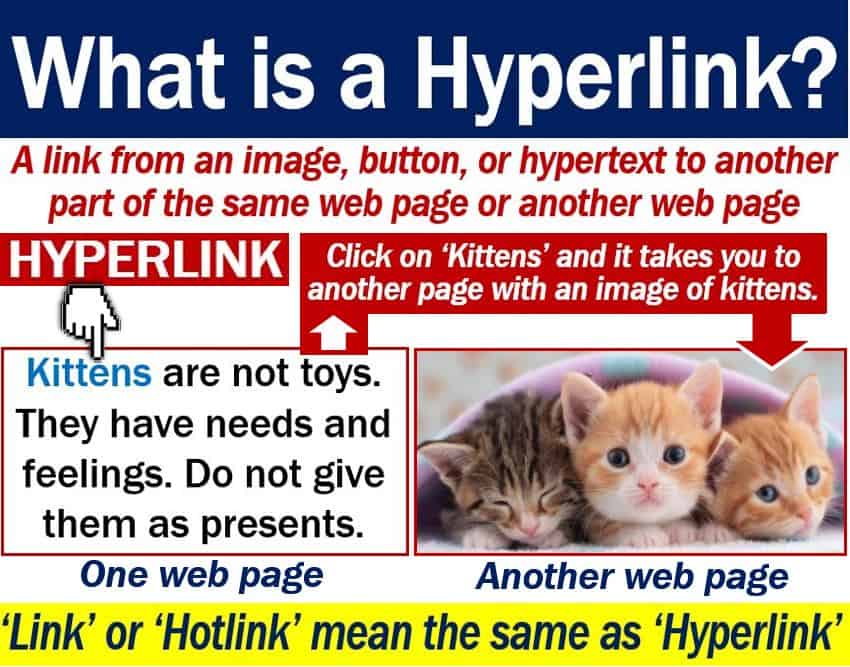A Hyperlink is a link from a drawing, button, image, or hypertext to another web page. It may also be a link to another part of the same web page. The person who is online taps or clicks on the hyperlink. They then automatically go to the link’s destination. On some web pages, users go to the link just by hovering over the relevant text, button, or image.
Hypertext is text that appears on electronic devices with hyperlinks to somewhere else.
The word can also be a verb, i.e., to create a hyperlink between documents or parts of a document.
We also use the terms ‘link‘ or ‘hotlink‘ with the same meaning as hyperlink.
When we refer to small pictures or drawings on our computers, we say ‘icons.‘

The strategic use of hyperlinks in digital marketing can guide a customer’s journey, leading from initial interest to informed purchase through interconnected content.
Who first used the term?
Ted Nelson first used the term in 1965 or 1964 at the beginning of Project Xanadu. He said that ‘As We May Think,’ a 1945 popular essay by Vannevar Bush, inspired him.
Bush described the Memex, a microfilm-based device in which people could link two pages of data. They could link them into a ‘trail’ of relevant information. They could then scroll back and forth among the trail’s pages.
Nelson, an American pioneer of IT, also coined the term hypermedia. IT stands for Information Technology.
Apple released a database program – HyperCard – for the Mackintosh in 1987. The program allowed hyperlinking between pages within a document.
Windows Help, which came with Microsoft Windows 3.0 in 1990, was full of hyperlinks.
Hyperlinks today are common in most web pages or websites (a website contains web pages). However, we can find them in other hypertext documents, such as glossaries, and dictionaries. We can also find them in encyclopedias and other references.
Moreover, hyperlinks are crucial for navigation in online learning environments, allowing students to access resources, additional readings, and related modules seamlessly.
In such cases, the hyperlinks act in the same way as they do online, i.e., they allow the user to jump from one page to another.
Many words linked to ‘hyperlinks’
Since the advent of the Internet near the end of the last century, the number of compound phrases containing the term ‘hyperlink’ have increased dramatically. Let’s look at some common ones:
-
Hyperlink Button
A button on a web page that functions as a hyperlink, often taking the user to a new page or a different section within the current page.
Example: “Click the ‘hyperlink button’ to register for the webinar.”
-
Hyperlink Icon
A graphical element that acts as a hyperlink; clicking on it takes the user to a linked page, document, or section.
Example: “The ‘hyperlink icon’ of a paperclip typically indicates an attachment.”
-
Hyperlink Navigation
The process of moving through different pages or sections of a website or document using hyperlinks.
Example: “Good ‘hyperlink navigation’ is key to providing a positive user experience on a website.”
-
Hyperlink Color
The color coding of text or icons that indicates a hyperlink, commonly blue and underlined by default.
Example: “The ‘hyperlink color’ should be distinct enough to stand out from the regular text.”
-
Hyperlink Tracking
The method of monitoring the clicks on hyperlinks to analyze user engagement and the effectiveness of content.
Example: “‘Hyperlink tracking’ helps us understand which parts of our newsletter are most interesting to our readers.”
Other languages
The notion of a ‘hyperlink’ exists across the globe, in English- and non-English-speaking nations. Here is a translation of the term in some of the most widely-spoken languages. In some countries, such as Germany and Japan, they use the English term:
Hipervínculo (Spanish), Hipervínculo (Portuguese), Hyperlink (German), Hyperlien (French), Iperlink (Italian), Hiperłącze (Polish), Гиперссылка (Russian), وصلة تشعبية (Arabic), هایپرلینک (Farsi), हाइपरलिंक (Hindi), ہائپر لنک (Urdu), হাইপারলিংক (Bengali), 超鏈接 (Cantonese Chinese), 超链接 (Mandarin Chinese), ハイパーリンク (Japanese), 하이퍼링크 (Korean), Tautan (Indonesian), Liên kết (Vietnamese), Hiperbağlantı (Turkish).
